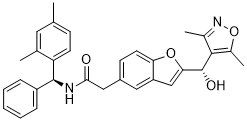TMP778
This product is for research use only, not for human use. We do not sell to patients.

For small sizes, please check our retail website as below: www.invivochem.com
| Size | Price | Stock |
|---|---|---|
| 100mg | $3225 | To Be Confirmed |
| 200mg | $4835 | To Be Confirmed |
| 500mg | $8160 | To Be Confirmed |
Cat #: V7133 CAS #: 1422053-04-0 Purity ≥ 99%
Description: TMP778 (TMP-778; TMP 778) is a novel and potent RORγt inverse agonist with potential anti-inflammatory activity.
Top Publications Citing Invivochem Products
Publications Citing InvivoChem Products
Product Promise

- Physicochemical and Storage Information
- Protocol
- Related Biological Data
- Stock Solution Preparation
- Quality Control Documentation
| Molecular Weight (MW) | 494.58 |
|---|---|
| Molecular Formula | C31H30N2O4 |
| CAS No. | 1422053-04-0 |
| SMILES Code | CC1=NOC(C)=C1[C@H](O)C2=CC3=CC(CC(N[C@@H](C4=CC=CC=C4)C5=CC=C(C=C5C)C)=O)=CC=C3O2 |
| Synonyms | TMP778; TMP-778; TMP 778 |
| Protocol | In Vitro | It is found that TMP778 at >2.5 μM starts to show toxic effects on cell growth, which however is not RORγt-dependent, since the proliferation of RORγt-deficient T cells cultured under Th17 cell-polarizing conditions is also decreased. Otherwise, these inhibitors do not show inhibitory effects on cell proliferation or RORγt expression or its nuclear translocation, but efficiently inhibited IL-17 production. TMP778 has a much broader dose range and efficiently decreased IL-17 production, consistent with its higher binding affinity for RORγt. These data indicate that TMP778 is the RORγt inhibitor that most potently reduced IL-17 production. |
|---|---|---|
| In Vivo | All three compounds (e.g., TMP778) delay the onset of disease and substantially reduce the severity of disease progression compared to control-treated mice. Consistent with in vitro results, TMP778 treatment causes the most pronounced effect on the disease phenotype. This treatment not only decreases the number of mononuclear cells infiltrating the central nervous system (CNS), but also most strongly reduces the percentage of IL-17+ T cells in the CNS (including IL-17+ IFNγ+). There is no significant change in the percentage IFNγ+ IL-17-T cells in the CNS among all groups, indicating that none of the inhibitors affects Th1 responses. TMP778 strongly inhibits Th17 cell generation, reduces IL-17 production from differentiated Th17 cells, and also dramatically ameliorates the progression of EAE. |
These protocols are for reference only. InvivoChem does not
independently validate these methods.
| Solvent volume to be added | Mass (the weight of a compound) | |||
|---|---|---|---|---|
| Mother liquor concentration | 1mg | 5mg | 10mg | 20mg |
| 1mM | 2.0219 mL | 10.1096 mL | 20.2192 mL | 40.4384 mL |
| 5mM | 0.4044 mL | 2.0219 mL | 4.0438 mL | 8.0877 mL |
| 10mM | 0.2022 mL | 1.0110 mL | 2.0219 mL | 4.0438 mL |
| 20mM | 0.1011 mL | 0.5055 mL | 1.0110 mL | 2.0219 mL |
The molarity calculator equation
Mass(g) = Concentration(mol/L) × Volume(L) × Molecular Weight(g/mol)
Mass
=
Concentration
×
Volume
×
Molecular Weight*
The dilution calculator equation
Concentration(start)
×
Volume(start)
=
Concentration(final)
×
Volume(final)
This equation is commonly abbreviated as: C1 V1 = C2 V2
Concentration(start)
C1
×
Volume(start)
V1
=
Concentration(final)
C2
×
Volume(final)
V2
Step One: Enter information below
Dosage mg/kg
Average weight of animals g
Dosing volume per animal µL
Number of animals
Step Two: Enter the in vivo formulation
%DMSO
+
%
+
%Tween 80
+
%ddH2O
Calculation Results:
Working concentration:
mg/ml;
Method for preparing DMSO master liquid:
mg
drug pre-dissolved in
µL
DMSO(Master liquid concentration
mg/mL)
,Please contact us first if the concentration exceeds the DMSO solubility of the batch of drug.
Method for preparing in vivo formulation:
Take
µL
DMSO master liquid, next add
µL
PEG300, mix and clarify, next add
µL
Tween 80,mix and clarify, next add
µL
ddH2O,mix and clarify.
Note:
- (1) Please be sure that the solution is clear before the addition of next solvent. Dissolution methods like vortex, ultrasound or warming and heat may be used to aid dissolving.
- (2) Be sure to add the solvent(s) in order.




































